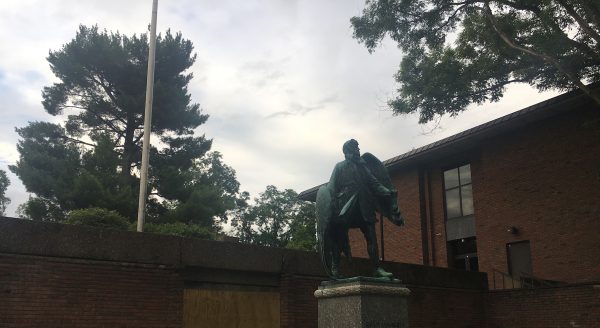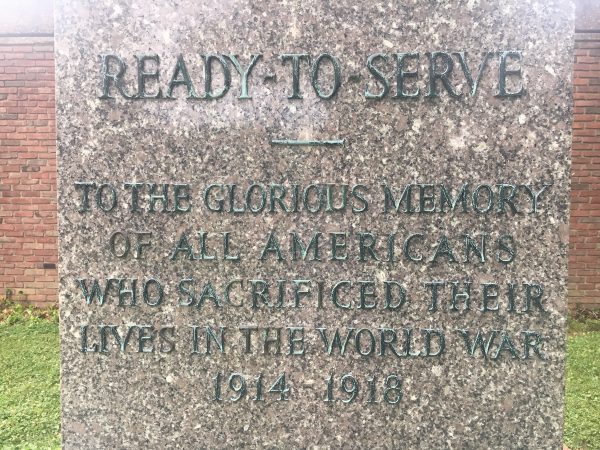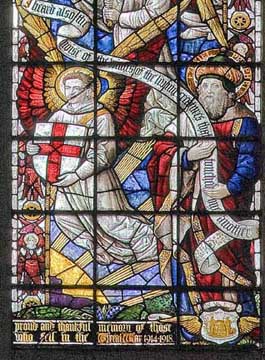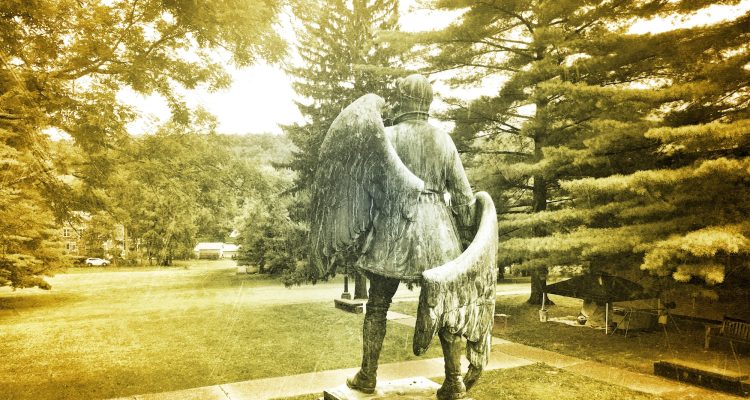When I was a small boy in the 1930s, my dad would take me to the Armistice Day ceremony at Linsly Military Institute which was located where the Kroger parking lot is now. It seems to me, in my recall, that pilots of World War I gathered in front of the Aviator statue dedicated to Louis Bennett Jr who was killed in action in the “big” war. They held a small ceremony and laid a wreath in remembrance of their fellow pilots who gave their all for their country. They seemed like old men to me, but they were most probably my dad’s age, in their 40s. There were maybe a dozen, give or take a few.

Armistice Day was celebrated on November 11th commemorating the official end of hostilities of that horrible carnage when all firing ceased on the eleventh hour of the eleventh day of the eleventh month in 1918. My dad and my first father-in-law, Andy Hess, who had fought in the trenches as a doughboy, were staunch traditionalists and never adjusted to changing it to make a 3 day weekend and renaming it Memorial Day. They persisted in observing Armistice Day on November 11th and closed their respective retail businesses, gave employees the day off with pay, went in in the morning, hung out the flag, and returned at 5pm to take it down.

Back to Louis Bennett Jr. When Gene Valentine lived here and was associated with Bethany College as a heavy donor, trying to build an equestrian program, he took a small group of business students he was mentoring on a tour of the major financial centers and invited me and a few others to join them. We had entree through Gene’s connections to the trading floors of Merrill Lynch in New York, London and Dubai. We also visited Amsterdam from an historical perspective.
While in London a few of the students joined me for a stroll through the streets of the city. We happened on Westminster Abbey where I remembered hearing about the “Aviator Window” so we entered. I inquired at the admissions desk about the window. The woman, pleased as punch, showed me their newly published colored catalogue of the stained glass windows in the cathedral with the Aviator Window on the cover. I told her we were from Wheeling,WV and knew the descendants of the Aviator. She became very excited and called the archivists who wanted to see us if we had time.
We were led to their offices through the huge structure, through the dusty old library with its high windows and stacks upon stacks of shelves, full of ancient books with wooden slats across front of the shelves locking the books in place.
We arrived at a formidable heavy wooden door, with big black hardware, up two, semi-circular, well worn stone steps which had been opened for us. We proceeded up a narrow, short flight of stairs into the small, cluttered offices of the archivists. They were excited and quite happy to see us. After a pleasant visit, they loaded me down with copies of the materials they had pertaining to the window. We were then guided to the stained glass window and were told how the window – the only one in the Cathedral with a human face- came into being.
Sometime after the war, England dedicated the tomb of their Unknown Soldier who was interred under the floor of the Cathedral. General Pershing, Commander of all the Allied Forces, was invited as the guest of honor. He, in turn, invited Mrs Bennett. During the dedication Mrs Bennett observed that one of the grand windows overlooking the tomb was blank. She later inquired if she could use the window to memorialize her son’s sacrifice during the war.
The Bennett family lived in Weston,WV and Louis Jr spent time here in the Ohio Valley. According to Dr. Charels A. Julian, he ” founded the West Virginia Aircraft Company (with a plant on Hess Avenue in Warwood), flew from an airfield in Beech Bottom, and maintained an office in Wheeling’s Schmulbach Building”.
Louis Jr was an only child who wanted to fight the German war machine and stop its subjugation of the free peoples of Europe before The United States entered the war. He tried in vain to organize The West Virginia Flying Corps for this purpose. He, then, entered the fight by joining the Royal Flying Corps and flying against the Germans in Europe downing enough German Balloons (9) and fighters (3) to be declared an Ace. He died as a result of enemy fire while attacking an enemy balloon on the ninth day of his active duty flying career. He had flown 25 sorties. He could not be officially honored as a hero by England because he was not British, nor could he be honored by his own United States, because we were not at war.
Mrs Bennett set out to give her son the honor he so justly deserved. She rebuilt the church in the French town Marquilles near the site of his death. Also, she commissioned the Aviator sculpture at the Linsly School in Wheeling,WV and the grand window in Westminster Cathedral in London. It is a large window with two smaller wing-like windows on either side.
When we returned to Wheeling, I gave the window catalogue and the copies of the materials I received to David McKinley, Sr, now Congressman McKinley and a relative of Louis Jr. We had a nice chat as he told me he had the letter that the German Balloon Commander, Emil Merkelbach, had sent to Louis’ mother extolling her son’s daring and courage as a fighter pilot and advising her that her son was buried by the Germans in a grave near where he had died with full Military Honors as was due a hero.

Near the lower border of the left “wing window” in Westminster Abbey is the state seal of West Virginia with the initials “ W.V.F.C.” commemorating the life of Lieutenant Louis Bennett Jr, West Virginia’s only ace from World War I .
Lindbergh visits Wheeling and “Tha Aviator”:




